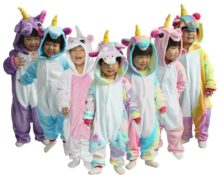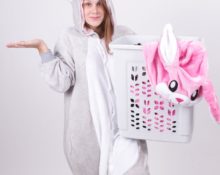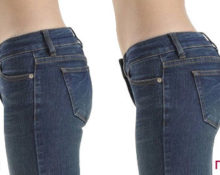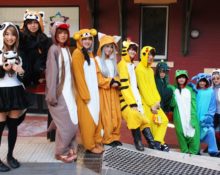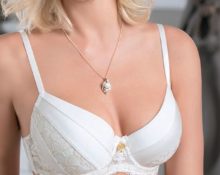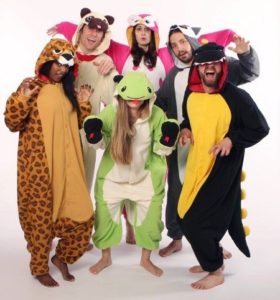 There are many costumes for adults and children in the world, but Onesies occupy a special place. Let's take a closer look at these creative costumes and how to sew them yourself.
There are many costumes for adults and children in the world, but Onesies occupy a special place. Let's take a closer look at these creative costumes and how to sew them yourself.
What is Onesie?
A huge number of modern performances cannot do without life-size puppets - this is kigurumi. But in ordinary life, these costumes are extremely uncomfortable, and walking around in the obligatory face mask is even more fun!
There are kigurumi - carnival, theatrical costumes, as well as kigurumi - pajamas and leisure suits.
Taking measurements
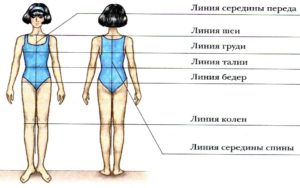 To create a pattern we will need:
To create a pattern we will need:
- Chest girth - we run a measuring tape along the convex places near the shoulder blades, along the chest.
- Waist circumference - measure at the thinnest part of the body.
- Hip circumference - place a measuring tape on the protruding part of the hip.
- Neck circumference - measure around the base of the neck, passing along the jugular cavity.
- The length of the product is from the base of the neck on the back to the desired length.
- The length of the sleeve is along the arm from the shoulder to the wrist, passing through the elbow.
- Body length - measure the distance from the armhole to the expected bow line.
- Front width - measured along the protruding points of the chest from one armhole to the other.
- Seat height - measured while sitting on a chair, perpendicular to the chair.
- Knee line - we lay it on the pattern parallel to the edge along the knee height. We measure from the estimated edge of the trouser leg to the knee.
- The height of the head is along the back of the head from the shoulders to the crown.
Materials for sewing kigurumi
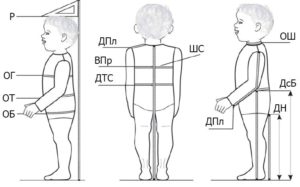
To make fun pajamas (kigurumi), any soft, elastic, well-draped fabric is used. It’s great if it’s fleecy and dense - plush, panvelvet, terry cotton fabric. Most often, various types of fleece are used, for example, fur fleece.
Important! Elastic materials can shrink up to ten percent, pay attention to this when purchasing fabric.
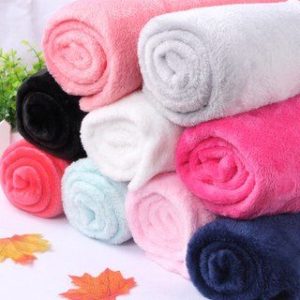
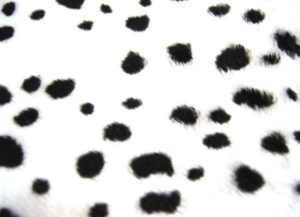 To work we will need:
To work we will need:
- Fleece-fur fabric – 2.5 -3 meters.
- Fleece-fur fabric (contrasting or complementary color) - 0.5 meters.
- The lock is a zipper 50-100 cm long (depending on the person’s height).
- Threads matching the color.
- Embroidery floss threads for finishing.
- Tracing paper or graph paper.
- Tailor's chalk, ruler.
- Pins.
- Sewing machine.
- Double knit needle, jersey foot (optional)
- Steamer or iron with iron.
Construction of a universal kigurumi pattern
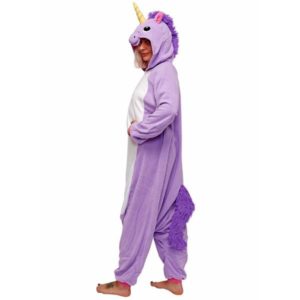 To create a pajama pattern, size is not very important; what matters, above all, is height. By increasing the same pattern, we can provide pajamas for the whole family. Let's figure out how to create an interesting kigurumi costume with your own hands.
To create a pajama pattern, size is not very important; what matters, above all, is height. By increasing the same pattern, we can provide pajamas for the whole family. Let's figure out how to create an interesting kigurumi costume with your own hands.
Patterns of permanent blanks:
- Front – 2.
- Back – 1 piece with fold.
- Hood – 2.
- Hood facing – 1 piece with fold.
- Sleeve cuffs – 2 folded parts.
- Leg cuffs – 2 folded parts.
Patterns of variable onesies blanks:
- Tail – 2.
- Ear outer side – 2.
- Ear inner side – 2.
- Teeth, eyes, eyebrows, horns etc.
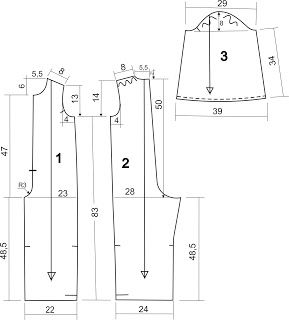
Universal kigurumi pattern
Preparing and cutting fabric
Before cutting, we process the fabric through a damp iron. Perhaps the material will “shrink”. If markers allow, wash and then dry the fabric.
Important! Be careful with pile material - some types cannot be ironed.
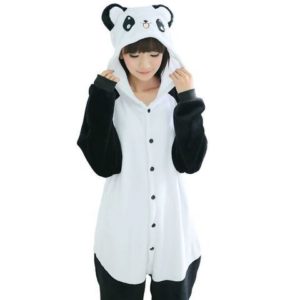 Fabric cutting:
Fabric cutting:
- The patterns are laid out in the direction of the grain, remembering that knitwear stretches in the transverse direction.
- We fold the fabric in half, lay out the patterns, and pin them together with the fabric.
- We outline the patterns with chalk, soap or pencil. We don’t use a ballpoint pen - there’s a chance it won’t wash off.
- We cut out the blanks.
Kigurumi models
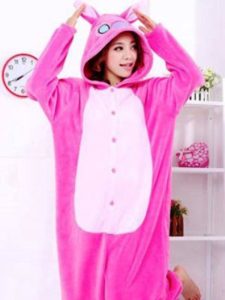 Types of pajamas - kigurumi are divided into animal costumes (raccoon, giraffe, cat, donkey, panda, and so on).
Types of pajamas - kigurumi are divided into animal costumes (raccoon, giraffe, cat, donkey, panda, and so on).
These can be costumes of fictional characters from cartoons, games, fairy tales (dragon, unicorn, various Pokemon, Totoro).
Advice! Before you start sewing, create a color sketch of the model. Mark all trim elements.
Using one pattern, you can sew a variety of one-piece models, complementing them with various finishing elements.
Kigurumi – Totoro
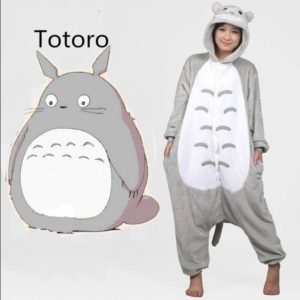 Initially, Totoro is a very chubby character, so we make very wide pajamas.
Initially, Totoro is a very chubby character, so we make very wide pajamas.
Required:
- The fabric is dark gray, 150 cm wide. For children's models, the amount of fabric is equal to the length of the product, for adults 1.5 lengths (the main parts of the product).
- Light gray or white fabric, 150 cm wide - 0.5 m (for the tummy).
- Zip closure.
- Black embroidery floss threads (for mustaches).
- Pink embroidery floss threads (for cheeks).
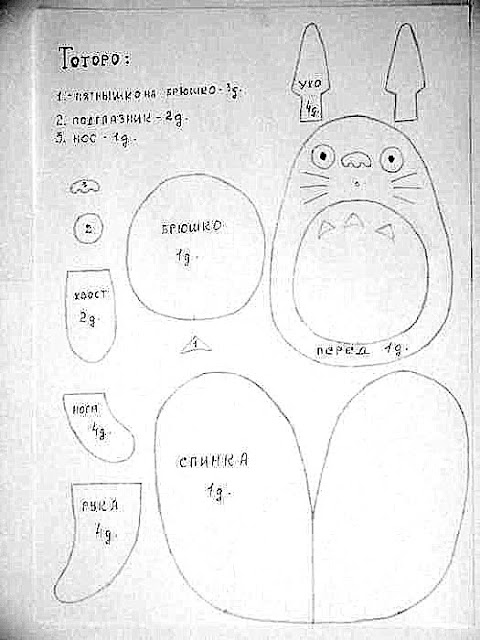 Pattern:
Pattern:
- Front – 2.
- Back – 1 piece with fold.
- Belly – 2.
- Sleeve – 2.
- Gusset – 1 piece, if large size.
- Hood – 2.
- Hood facing – 1 piece with fold.
- Sleeve cuffs – 2 folded parts.
- Leg cuffs – 2 folded parts.
- Ear 4.
- Tail – 2.
- Spots for the tummy – 8-10.
- Smile – 1 piece with a fold.
- Eyes – 2.
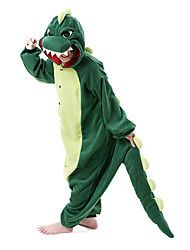
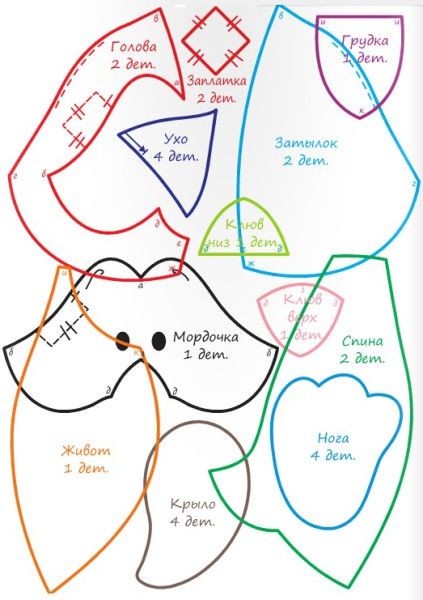 Subsequence:
Subsequence:
- We cut out the blanks.
- Sew the spots to the tummy. You can just use a small zigzag stitch.
- We sew the tummy to the front parts.
- Sew the shoulder seams.
- Sew the side seams.
- Sew on the gusset (optional).
- We perform a step seam.
- Sew on the tail.
Advice! It is better to sew the tail to the pajamas the person is wearing so that it is in the right place.
- We sew in the sleeves.
- We sew the cuffs to the sleeves and trouser legs.
- Sew the hood. We sew ears to it.
- We sew the elements of the muzzle to the hood.
- We embroider a mustache.
- We process it with a facing.
- We sew in a zipper.
- Let's try on onesies.
- Kigurumi is a dragon.
Kigurumi with buttons
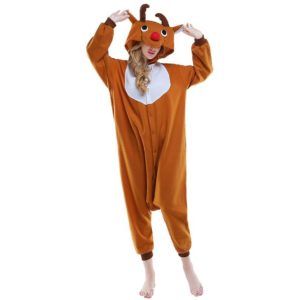 We will sew this one-piece model with buttons and one-piece sleeves.
We will sew this one-piece model with buttons and one-piece sleeves.
Required:
- Green fabric, 150 cm wide. For children's models, the amount of fabric is equal to the length of the product, for adults 1.5 lengths (main parts).
- Fabric of yellow or light green color, 150 cm wide - 0.5 m (for the tummy and tail ridge).
- Red fabric - flaps (for the inside of the hood.)
- 6-8 buttons.
Pattern:
- Front – 2.
- Back – 2.
- Belly – 2.
- Gusset – 1 piece, if large size.
- Hood – 2.
- Hood facing – 1 piece with fold.
- Sleeve cuffs – 2 folded parts.
- Leg cuffs – 2 folded parts.
- Comb – 24.
- Tail – 2.
- Teeth 10-14.
- Eyebrows – 4.
- Eyes – 2.
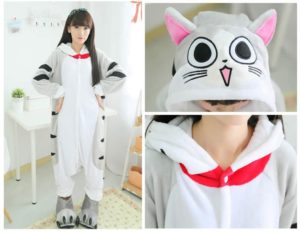 Subsequence:
Subsequence:
- We cut out the blanks.
- We sew the belly to the front panel.
- We sew the parts of the comb together in pairs.
- We sew the comb into the middle seam of the back, tail and hood.
- Sew the shoulder seams.
- Sew the side seams.
- Sew on the gusset (optional).
- We perform a step seam.
- Sew on the tail.
Advice! It is better to sew the tail to the pajamas the person is wearing so that it is in the right place.
- We sew the cuffs to the sleeves and trouser legs.
- Sew the hood. We sew eyes and eyebrows to it.
- We sew the parts of the teeth together in pairs.
- Sew on the teeth.
- We process the hood with facing.
- We make a fastener - a bar on the front of the pajamas.
- Sew on the buttons.
- Let's try on onesies.
Onesie pajamas are a great way to remember your childhood while still being an adult. You can sew identical onesies for everyone in your household and have a pajama party. You will only need a few hours to sew one product, but it will delight you for many years.


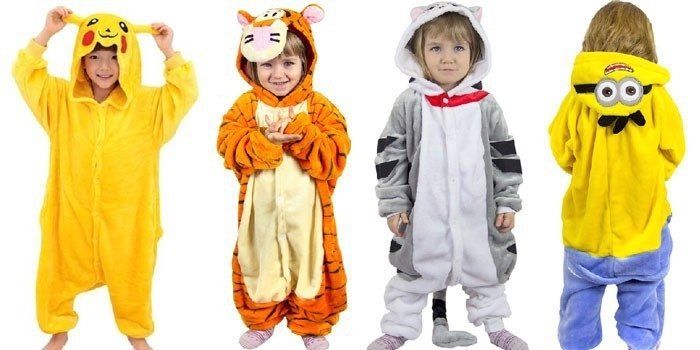 Advice! It is better to sew the tail to the pajamas the person is wearing so that it is in the right place.
Advice! It is better to sew the tail to the pajamas the person is wearing so that it is in the right place.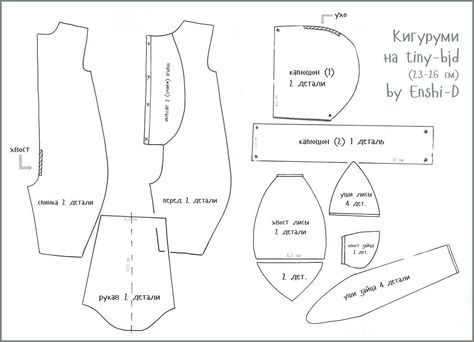 Advice! It is better to sew the tail to the pajamas the person is wearing so that it is in the right place.
Advice! It is better to sew the tail to the pajamas the person is wearing so that it is in the right place. 1
1
